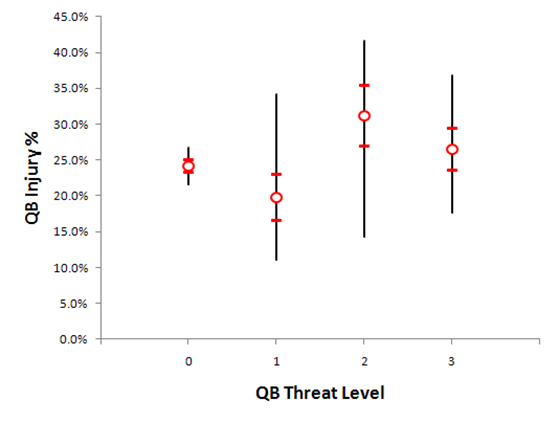QB Fragility Update
My first diary ever was a look at the hypothesis that option QBs get hurt with a higher frequency due to the extra hits the are exposed to. I followed that one up with an expanded data set to include 5 seasons instead of 1. This update adds 2009 to the set and gives the helihat a spin that I had not gone through the trouble of in the previous diaries.
For the forcier-like detail on what was done, please refer to those diaries and discussions. But here’s a high level summary:
- The scope was all FBS schools and all QBs with significant playing time. Significant playing time is defined as players who average more than 17 plays (passes + runs) per game they played in. This level is based on the median of the data (50-50 split on either side of the line).
- QBs were binned into 4 groups according to their run-to-pass ratio.
- Injuries and games lost (quarter game resolution) were tracked and statistic-ated.
Here’s the data. Sorry for the table not being copy&paste-able, Windows Live Writer was not cooperating with me.
Last season was a bad year for non-zero threat level QBs with levels 1-3 coming in above 30%. It’s important to note here that sample size is a factor in this. For example, each level 3 QB accounts for about 5% of that population so one injury sways the percentage by quite a bit. This is a big reason why there is so much variation in the injury rates for levels 1-3 from year to year. The aggregate totals are much more reliable because, at this point, each category has plenty of observations with which to make conclusions.
The graph above shows the overall range (black line), average (red circles), and the standard error of the average (red hashes) for each category. At first blush it looks like there’s a difference in the injury rates of level 1, 2, and 0/3 but the fact of the matter is that there is insufficient evidence to support this. I actually ran hypothesis tests this time and that was the outcome (failure to reject the null hypothesis that A=B=C=D). Note that this does not mean that no difference exists, simply that there is no reason to conclude that a difference does exist. The differences observed are statistically insignificant.
People who believe that option QBs get injured more often do so because that’s what they want to believe.
April 24th, 2010 at 10:06 PM ^
April 24th, 2010 at 11:23 PM ^
April 25th, 2010 at 12:59 AM ^
August 14th, 2013 at 10:51 AM ^


Comments